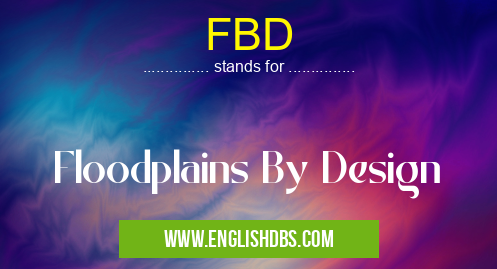What does FBD mean in UNCLASSIFIED
FBD stands for Floodplains By Design. It is a nature-based flood management approach that aims to reduce flooding risks while preserving or restoring the natural functions of floodplains.

FBD meaning in Unclassified in Miscellaneous
FBD mostly used in an acronym Unclassified in Category Miscellaneous that means Floodplains By Design
Shorthand: FBD,
Full Form: Floodplains By Design
For more information of "Floodplains By Design", see the section below.
FBD Meaning in Miscellaneous
FBD is categorized under the miscellaneous category as it encompasses various aspects of flood management and environmental preservation.
FBD Full Form
Floodplains By Design (FBD)
What does FBD Stand for
Floodplains By Design
Principles of FBD
- Reconnecting rivers with their floodplains: Restoring natural connections between rivers and their floodplains allows floodwaters to spread out and slow down, reducing flood peaks and the risk of inundation.
- Protecting and enhancing wetlands: Wetlands serve as natural sponges, absorbing and storing floodwaters. FBD aims to protect and restore wetlands to increase their floodwater storage capacity.
- Implementing floodable green spaces: Creating floodable parks, green roofs, and other green infrastructure can provide additional storage for floodwaters and reduce runoff.
- Encouraging sustainable land use practices: Promoting land use practices that minimize impervious surfaces and preserve natural drainage patterns can reduce the amount of runoff that contributes to flooding.
Essential Questions and Answers on Floodplains By Design in "MISCELLANEOUS»UNFILED"
What is Floodplains By Design (FBD)?
Floodplains By Design (FBD) is a comprehensive river management approach that prioritizes natural processes and ecosystem restoration to reduce flood risk and improve river health. By working with nature, FBD aims to create resilient, adaptable, and sustainable river systems.
How does FBD differ from traditional flood management methods?
Traditional flood management often relies on structural measures, such as dams and levees, to control water flow. In contrast, FBD emphasizes non-structural solutions that restore natural floodplain functions, such as flood storage, sediment transport, and riparian habitat. This approach recognizes that rivers are dynamic systems that need space to function properly and that working with nature can provide multiple benefits beyond flood risk reduction.
What are the key elements of FBD?
Key elements of FBD include:
- Restoring natural floodplain connectivity by removing or modifying structures that impede water flow.
- Reconnecting rivers to their floodplains to allow for flood storage and sediment deposition.
- Enhancing riparian vegetation to provide habitat and stabilize banks.
- Promoting sustainable land use practices in floodplains to reduce erosion and sedimentation.
- Engaging with local communities to develop tailored solutions that meet their needs.
What are the benefits of implementing FBD?
Implementing FBD can provide numerous benefits, including:
- Reduced flood risk for communities and infrastructure
- Improved water quality and aquatic habitat
- Increased recreational opportunities
- Enhanced resilience to climate change
- Reduced maintenance and repair costs
How can I get involved in FBD?
To get involved in FBD, you can:
- Contact local floodplain managers or conservation organizations
- Attend public meetings and workshops
- Support policies that promote FBD principles
- Volunteer to restore and protect floodplain areas
Final Words: FBD offers a comprehensive and sustainable approach to flood management that addresses both the risks of flooding and the need to protect the environment. By implementing FBD principles, communities can reduce flood risks, improve water quality, enhance biodiversity, and create more livable and resilient urban environments.
FBD also stands for: |
|
| All stands for FBD |
